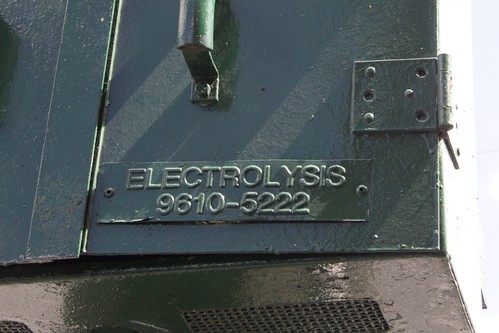If you are eagle eyed during your travels around Melbourne, you might have spotted one of these signs.
Despite what the plate says, this isn’t some kind of bizarre advertising for a hair removal clinic, as electrolysis has a second meaning in engineering circles – the corrosion of metals due to stray electrical currents. In Melbourne electrolysis became an issue after the first electric trains entered service in 1919.
Electric trains and trams in Melbourne use direct current, with the positive feed from the substation to the train via overhead wires and the pantograph on the roof, with the current returned to the substation via the steel rails and the train wheels.
This works well in theory, but in reality electricity takes the path of least resistance: in this case some of the return current flows through the earth and is attracted by buried metallic objects such as water mains. Corrosion occurs when the current finally leaves the buried object, with the buried pipe in effect the anode of a simple electrochemical cell.

Corrosion of buried pipes is not a good thing – one amp of current for one year results in a loss of 9 kilograms of steel!
This much metal going missing causes big troubles – in 1922 a 900 mm diameter water main failed in Punt Road, resulting in a hole in the ground measuring 10 metres by 12 metres in size! After much to-and-fro between the Victorian Railways and the Melbourne Metropolitan Board of Works in regards to the cause, the State Government held an inquiry into solving the electrolysis issue.
This resulted in the formation of the Melbourne Electrolysis Committee in 1927: members included the railway and tramway operators who are considered the “instigators” of the issue; as well as the electricity, water, gas, telecommunications and oil industries, who suffered damage to their infrastructure.
Now known as the Victorian Electrolysis Committee, corrosion of burred assets is now be controlled in two ways:
- Drainage bonds: the buried metal to be protected is connected back to the rails with a diode and a resistor, giving stay currents a more conductive path back to there they should be.
- Cathodic protection: the metal to be protected is electrically connecting to another more easily corroded metal, forcing it to be the anode of the electrochemical cell
You can read more about the Victorian Electrolysis Committee and what they do in their Code of Practice – you know you want to…
Further reading
- The Elephant and the Flea – Living with Traction Return: a technical paper by Paul Szacsvay from the Rail Corporation NSW
- Earthing, Bonding and Electrolysis – The DC Traction Challenge: a technical presentation by Barry Finlay
- Menace of Electrolysis: Force That Works Unseen: an article from the February 15, 1937 edition of The Age




Marcus, excuse my ignorance, but I see a few “cabinets” attached to power poles (usually along tram routes), with Electrolysis and the phone number printed on them. What would these actually be?
I believe the boxes you are seeing house the drainage bonds mentioned in the article – the equipment inside the box connects the tramway rails and the burred metal pipes to be connected together. By doing this the stray currents are directed back to the substation via overhead wires, and not via the pipes where they cause corrosion.
Thanks Marcus!